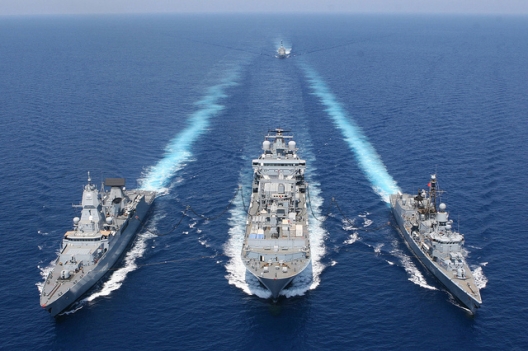 Excerpts from the European Union Maritime Security Strategy.
Excerpts from the European Union Maritime Security Strategy.
STRENGTHENING THE EU RESPONSE
Building on the aforementioned objectives and principles and taking into account existing achievements, the following five main areas of implementation to strengthen the EU response have been identified.
1. External action
The objective is to promote better rules-based maritime governance and make effective use of the EU instruments at hand. In order to achieve that, actions need to focus on:
a) Working towards a coordinated approach on maritime security issues in international fora, regional bodies and third countries;
b) Enhancing the visibility of the EU in the glob al maritime domain;
c) Strengthening the coherence between all EU civilian and military instruments and policies, the coordination between EU Services, including its agencies, and Member States involved, both at sea and on land, applying a pooling and sharing approach for the available resources, where appropriate, while respecting Member States’ internal organisation and EU and national policies and legislation;
d) Reinforcing the preparation for future maritime security contingencies and mainstreaming maritime security into the Common Foreign and Security Policy (CFSP) agenda, in close cooperation with all relevant EU actors, in line with the EU’s comprehensive approach;
e) The conduct of maritime security capacity building activities with third countries and regional organisations, in order to enhance their capacities in the fields of 1) maritime governance and rule of law, including criminal justice and maritime law enforcement; 2) port and maritime transport security to international agreed standards; 3) capabilities to manage their own borders; and 4) combatting IUU fishing. Thereby existing international, EU and national export control regulations should be fully respected;
f) Promoting the dispute settlement mechanisms according to the UNCLOS, including the International Tribunal for the Law of the Sea, in the political dialogues of the EU with third countries and regional organisations.
2. Maritime awareness, surveillance and information sharing
In order to achieve this objective, actions need to focus on:
a) Further improving cross-sectoral cooperation and interoperability at national and EU level as regards integrated maritime surveillance within the framework of the respective Member State
and EU authorities and responsibilities;
b) Strengthening cross-border cooperation and information exchange to optimize the surveillance of the EU maritime area and its maritime borders;
c) A consistent approach in supporting maritime surveillance in the EU and the global maritime domain and the planning and conduct of CSDP missions and operations;
d) The development of the Common Information Sharing Environment (CISE).
3. Capability development
In this respect, actions need to focus on:
a) Promoting pooling and sharing initiatives and projects, as well as training and education, pursued by Member States including through EDA and other relevant civilian and military actors; good coordination and mutual reinforcement with NATO in order to ensure complementarity and increase coherence should continue;
b) Identifying capability areas and technologies that could benefit from additional investment, improving harmonisation for better interoperability, standardisation and certification;
c) The development of dual-use and multipurpose capabilities and the exploration of options for their better use;
d) Making best use of and creating synergies between information, capabilities and systems managed by civilian and military authorities up to multipurpose and multinational missions;
e) Promoting greater sharing of best practices, risk analysis and threat information, as well as training and education, amongst all relevant civilian and military fora such as the European Coast Guard Functions Forum and the Chiefs of European Navies, taking into account the maritime operational plans in force between Member States and the regional agreements in the EU.
4. Risk management, protection of critical maritime infrastructure and crisis response
Actions to achieve the above objectives need to focus on:
a) Achieving a common risk analysis in order to develop a shared maritime security risk management and, where applicable, complement established international and EU maritime security risk analysis requirements;
b) Enhancing cross-sectoral as well as cross border cooperation for maritime crisis response and planning on maritime security contingencies in relation to defined security threats, also taking into account the Council Decision on the arrangements for the implementation of the Solidarity Clause;
c) Assessing the resilience of maritime transport infrastructure to natural and man-made disasters, including climate change, and take appropriate adaptive actions and share best practices in order to mitigate related risks;
d) Promoting a mutual understanding to increase interoperability amongst maritime security actors.
5. Maritime security research and innovation, education and training
In order to achieve this objective, actions need to focus on:
a) Bringing together available maritime security-related training opportunities in common Maritime Training Modules;
b) Establishing a civil-military agenda for maritime security research including the development of dual-use and multipurpose capabilities;
c) Establishing new and further developing existing networks for knowledge and competence development for civilian and military educational institutes, centres and academies;
d) Creating a network of global research and development partners;
e) Whereas research and innovation activities, such as under Horizon 2020, focus on civil applications, interaction with activities of EDA will be actively pursued in the field of maritime security;
f) Promoting public-private partnerships;
g) Promoting the conduct of inter-agency, joined-up exercises.
Image: EU Operation Atalanta, Nov. 15, 2010 (photo: Bundeswehr)
